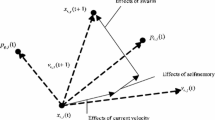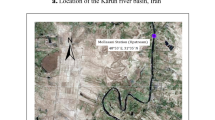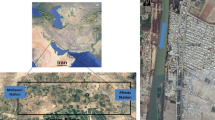Abstract
The Muskingum model is a popular method for flood routing in river engineering. This model has several parameters, which should be estimated. Most of the techniques have applied to estimate these parameters to reduce the distance between observed flow and estimated flows. In this paper, for the first time, the parameters of a novel form of the nonlinear Muskingum model are estimated by the Particle Swarm Optimization (PSO) algorithm. The new Muskingum model, which have four parameters, is applied for three benchmark examples and one real case in Iran. The sum of the squared (SSQ) or absolute (SAD) deviations between the observed and estimated outflows was considered as objective functions. The results showed that although the new Muskingum model became more complex but this model by using PSO technique can improve the fit to observed flow especially in multiple-peak hydrographs.






Similar content being viewed by others
References
Afshar A, Kazemi H, Saadatpour M et al. (2011) Particle swarm optimization for automatic calibration of large scale water quality model (CE-QUAL-W2): application to Karkheh Reservoir, Iran. Water Resour Manag 2613–2632. doi: 10.1007/s11269-011-9829-7
Al-Humoud JM, Esen II (2006) Approximate methods for the estimation of Muskingum flood routing parameters. Water Resour Manag 20:979–990. doi:10.1007/s11269-006-9018-2
AT Committee, others (1993) The ASCE task committee on definition of criteria for evaluation of watershed models of the watershed management committee Irrigation and Drainage Division, Criteria for evaluation of watershed models. J Irri Drain Engng, ASCE 119:429–442
Bajracharya K, Barry DA (1997) Accuracy criteria for linearised diffusion wave flood routing. J Hydrol 195:200–217
Barati R (2011) Parameter estimation of nonlinear Muskingum models using Nelder-Mead simplex algorithm. J Hydrol Eng 365–367. doi: 10.1061/(ASCE)HE.1943-5584.0000367
Barati R (2013) Application of Excel Solver for parameter estimation of the nonlinear Muskingum models
Carvalho M, Ludermir T (2006) An analysis Of PSO hybrid algorithms for feed-forward neural networks training. 2006 Ninth Brazil Symposium Neural Networks (SBRN’06) 2–2. doi: 10.1109/SBRN.2006.10.
Chau K (2005) A split-step PSO algorithm in prediction of water quality pollution. 1034–1039
Chu H-J (2009) The Muskingum flood routing model using a neuro-fuzzy approach. KSCE J Civ Eng 13:371–376. doi:10.1007/s12205-009-0371-6
Chu H, Chang L (2009) Applying particle swarm optimization to parameter estimation of the nonlinear Muskingum model. J Hydrol Eng 17:1139–1148. doi:10.1007/s12205-013-0037-2
Das A (2004) Parameter estimation for Muskingum models. J Irrig Drain Eng 0:140–147
Das A (2007) Chance-constrained optimization-based parameter estimation for Muskingum models. J Irrig Drain Eng 133:487–494
De Moura Meneses AA, Machado MD, Schirru R (2009) Particle swarm optimization applied to the nuclear reload problem of a pressurized water reactor. Prog Nucl Energy 51:319–326
Easa S (2013) New and improved four-parameter non-linear Muskingum model. Proc ICE-Water Manag 1–3.
Eberhart R, Kennedy J (1995) A new optimizer using particle swarm theory. MHS’95 Proc Sixth Int Symposium Micro Mach Human Sci. doi: 10.1109/MHS.1995.494215
Geem Z (2006) Parameter estimation for the nonlinear Muskingum model using the BFGS technique. J Irrigation Drain Eng 1270–1279
Geem Z (2010) Parameter estimation of the nonlinear Muskingum model using parameter-setting-free harmony search. J Hydrol Eng 684–688. doi: 10.1061/(ASCE)HE.1943-5584.0000352
Gill MA (1978) Flood routing by the Muskingum method. J Hydrol 36:353–363
Je N, Sutcliffe JV (1970) River flow forecasting through conceptual models part I—a discussion of principles. J Hydrol 10:282–290
Karahan H, Gurarslan G, Geem Z et al. (2012) Parameter estimation of the nonlinear Muskingum flood-routing model using a hybrid harmony search algorithm. J Hydrol … 352–360. doi: 10.1061/(ASCE)HE.1943-5584.0000608.
Kim JH, Geem ZW, Kim ES (2001) Parameter estimation of the nonlinear Muskingum model using harmony search. J Am Water Resour Assoc 37:1131–1138. doi:10.1111/j.1752-1688.2001.tb03627.x
Kuo RJ, Hong SY, Huang YC (2010) Integration of particle swarm optimization-based fuzzy neural network and artificial neural network for supplier selection. Appl Math Model 34:3976–3990. doi:10.1016/j.apm.2010.03.033
Latt ZZ (2015) Application of feedforward artificial neural network in Muskingum flood routing : A Black-Box Forecasting Approach Nat River Syst. doi: 10.1007/s11269-015-1100-1
Li Y, Bai B, Zhang Y (2010) Improved particle swarm optimization algorithm for fuzzy multi-class SVM. Syst Eng Electron, J 21:509–513
Lu WZ, Fan HY, Leung AYT, Wong JCK (2002) Analysis of pollutant levels in central Hong Kong applying neural network method with particle swarm optimization. Environ Monit Assess 79:217–230
Luo J, **e J (2010) Parameter estimation for nonlinear muskingum model based on immune clonal selection algorithm. J Hydrol Eng 15:844–851. doi:10.1061/(ASCE)HE.1943-5584.0000244
Mays LW (2010) Water resources engineering. John Wiley & Sons
McCuen RH, Knight Z, Cutter AG et al. (2006) Evaluation of the Nash--Sutcliffe efficiency index
Meraji SH (2004) Optimum design of flood control systems by particle swarm optimization algorithm. M. Sc. thesis, Iran University of Science and Technology
Mohan S (1997) Parameter estimation of nonlinear Muskingum models using genetic algorithm. J Hydraul Eng 123:137–142
Nagesh Kumar D, Janga Reddy M (2007) Multipurpose reservoir operation using particle swarm optimization. J Water Resour Plan Manag 133:192–201
Natural Environment Research Council (NERC) (1975) Flood studies report. Institute of Hydrology, Wallingford, U.K.
Niazkar M, Afzali SH (2014) Assessment of modified honey bee mating optimization for parameter estimation of nonlinear muskingum models. 1–13. doi: 10.1061/(ASCE)HE.1943-5584
O’DONNELL T (1985) A direct three-parameter Muskingum procedure incorporating lateral inflow. Hydrol Sci J 30:479–496
Orouji H, Haddad OB, Fallah-Mehdipour E, Mariño MA (2013) Estimation of Muskingum parameter by meta-heuristic algorithms. Proc Inst Civil Eng: Water Manag 166(6):315–324. doi:10.1680/wama.11.00068
Prakash K, Sydulu M (2007) Particle swarm optimization based capacitor placement on radial distribution systems. In: Power Engineering Society General Meeting, 2007. IEEE. pp 1–5
Toprak ZF (2009) Flow discharge modeling in open canals using a new fuzzy modeling technique (SMRGT). CLEAN--Soil, Air, Water 37:742–752
Tung Y-K (1985) River flood routing by nonlinear Muskingum method. J Hydraul Eng 111:1447–1460
Wilson EM (1974) Engineering hydrology.Macmillan Education, Hampshire, U.K
Xu D-M, Qiu L, Chen S-Y (2011) Estimation of nonlinear Muskingum model parameter using differential evolution. J Hydrol Eng 17:348–353
Yoon J, Padmanabhan G (1993) Parameter estimation of linear and nonlinear Muskingum models. J Water Resour Plan Manag 119:600–610
Zaji AH, Bonakdari H (2014) Performance evaluation of two different neural network and particle swarm optimization methods for prediction of discharge capacity of modified triangular side weirs. Flow Meas Instrum 40:149–156
Author information
Authors and Affiliations
Corresponding author
Ethics declarations
Conflict of Interest
The authors declare that they have no conflict of interest.
Rights and permissions
About this article
Cite this article
Moghaddam, A., Behmanesh, J. & Farsijani, A. Parameters Estimation for the New Four-Parameter Nonlinear Muskingum Model Using the Particle Swarm Optimization. Water Resour Manage 30, 2143–2160 (2016). https://doi.org/10.1007/s11269-016-1278-x
Received:
Accepted:
Published:
Issue Date:
DOI: https://doi.org/10.1007/s11269-016-1278-x




